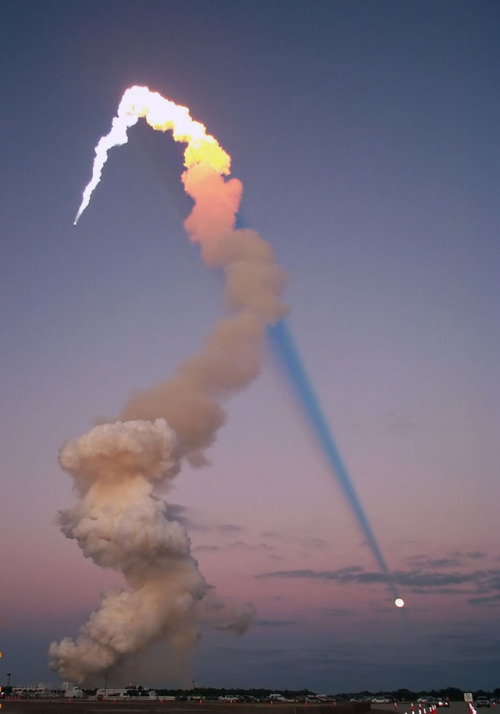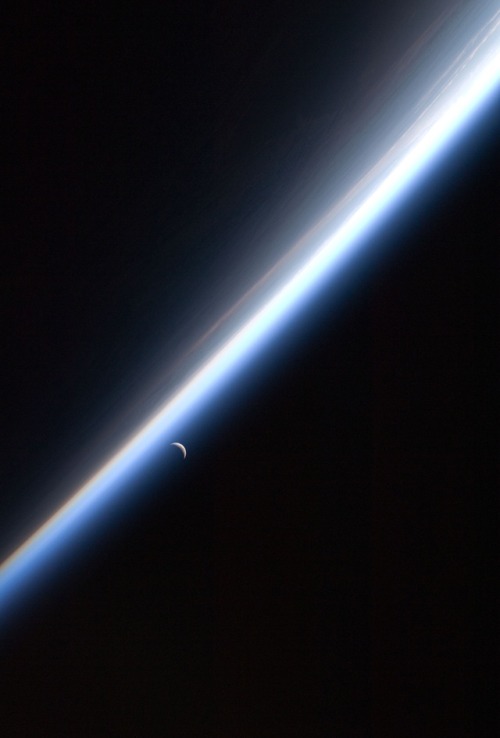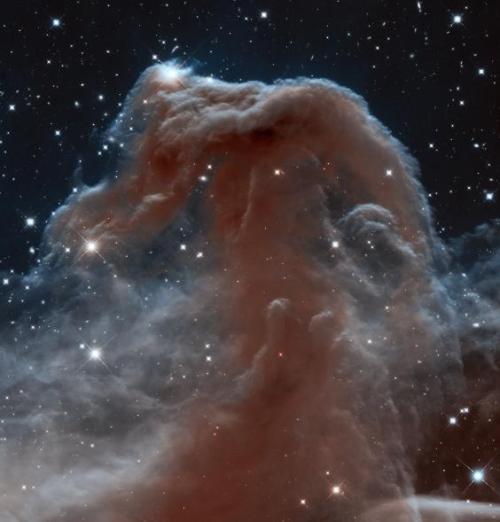In Early 2001 During A Launch Of Atlantis, The Sun, Earth, Moon, And Rocket Were All Properly Aligned

In early 2001 during a launch of Atlantis, the Sun, Earth, Moon, and rocket were all properly aligned for this photogenic coincidence.
Image Credit: Pat McCracken, NASA
More Posts from Jmsconn and Others

To the Moon and Beyond: Why Our SLS Rocket Is Designed for Deep Space
It will take incredible power to send the first woman and the next man to the Moon’s South Pole by 2024. That’s where America’s Space Launch System (SLS) rocket comes in to play.

Providing more payload mass, volume capability and energy to speed missions through deep space than any other rocket, our SLS rocket, along with our lunar Gateway and Orion spacecraft, creates the backbone for our deep space exploration and Artemis lunar mission goals.
Here’s why our SLS rocket is a deep space rocket like no other:
It’s a heavy lifter

The Artemis missions will send humans 280,000 miles away from Earth. That’s 1,000 times farther into space than the International Space Station. To accomplish that mega feat, you need a rocket that’s designed to lift — and lift heavy. With help from a dynamic core stage — the largest stage we have ever built — the 5.75-million-pound SLS rocket can propel itself off the Earth. This includes the 57,000 pounds of cargo that will go to the Moon. To accomplish this, SLS will produce 15% more thrust at launch and during ascent than the Saturn V did for the Apollo Program.
We have the power

Where do our rocket’s lift and thrust capabilities come from? If you take a peek under our powerful rocket’s hood, so to speak, you’ll find a core stage with four RS-25 engines that produce more than 2 million pounds of thrust alongside two solid rocket boosters that each provide another 3.6 million pounds of thrust power. It’s a bold design. Together, they provide an incredible 8.8 million pounds of thrust to power the Artemis missions off the Earth. The engines and boosters are modified heritage hardware from the Space Shuttle Program, ensuring high performance and reliability to drive our deep space missions.
A rocket with style

While our rocket’s core stage design will remain basically the same for each of the Artemis missions, the SLS rocket’s upper stage evolves to open new possibilities for payloads and even robotic scientific missions to worlds farther away than the Moon like Mars, Saturn and Jupiter. For the first three Artemis missions, our SLS rocket uses an interim cryogenic propulsion stage with one RL10 engine to send Orion to the lunar south pole. For Artemis missions following the initial 2024 Moon landing, our SLS rocket will have an exploration upper stage with bigger fuel tanks and four RL10 engines so that Orion, up to four astronauts and larger cargoes can be sent to the Moon, too. Additional core stages and upper stages will support either crewed Artemis missions, science missions or cargo missions for a sustained presence in deep space.
It’s just the beginning

Crews at our Michoud Assembly Facility in New Orleans are in the final phases of assembling the core stage for Artemis I— and are already working on assembly for Artemis II.
Through the Artemis program, we aim not just to return humans to the Moon, but to create a sustainable presence there as well. While there, astronauts will learn to use the Moon’s natural resources and harness our newfound knowledge to prepare for the horizon goal: humans on Mars.
Make sure to follow us on Tumblr for your regular dose of space: http://nasa.tumblr.com

Wide-Field Collision




Total Solar Eclipse, 2019. Credits: ESA/CESAR










We were founded in New Taipei, Taiwan in 2005. We are a professional manufacturer of automotive diagnostic wires(OEM,OBM,ODM). For customers, we adhere to the principle of customer supremacy and strive to meet the requirements as a business philosophy. With professional technical strength, flexible production operation, and responsible and active attitude, we ensure that products gallop at high speed in the transmission of information, so as to ensure that customers can continuously get the greatest satisfaction while using the product.
www.vobd.com.tw

Lunar Focus


Crescent Moon and Earth’s Atmosphere Seen by International Space Station
Credit: NASA

Shuttle Launch As Seen From Space

Known as the Horsehead Nebula – but you can call it Starbiscuit.
Found by our Hubble Space Telescope, this beauty is part of a much larger complex in the constellation Orion.
Make sure to follow us on Tumblr for your regular dose of space: http://nasa.tumblr.com.
-
 hvndrixx reblogged this · 4 months ago
hvndrixx reblogged this · 4 months ago -
 hvndrixx liked this · 4 months ago
hvndrixx liked this · 4 months ago -
 loudcowboygladiator liked this · 4 months ago
loudcowboygladiator liked this · 4 months ago -
 electranavy reblogged this · 5 months ago
electranavy reblogged this · 5 months ago -
 girlagony reblogged this · 5 months ago
girlagony reblogged this · 5 months ago -
 wnderlust-xo liked this · 5 months ago
wnderlust-xo liked this · 5 months ago -
 marcusauralius1111 reblogged this · 5 months ago
marcusauralius1111 reblogged this · 5 months ago -
 curlyclouds liked this · 5 months ago
curlyclouds liked this · 5 months ago -
 aphroditedoppelganger reblogged this · 5 months ago
aphroditedoppelganger reblogged this · 5 months ago -
 aphroditedoppelganger liked this · 5 months ago
aphroditedoppelganger liked this · 5 months ago -
 ultramilkshakeblr liked this · 6 months ago
ultramilkshakeblr liked this · 6 months ago -
 soon--soon liked this · 6 months ago
soon--soon liked this · 6 months ago -
 animasmagic liked this · 8 months ago
animasmagic liked this · 8 months ago -
 paperbaghero liked this · 8 months ago
paperbaghero liked this · 8 months ago -
 ssoftluv liked this · 8 months ago
ssoftluv liked this · 8 months ago -
 venvenvenadito reblogged this · 9 months ago
venvenvenadito reblogged this · 9 months ago -
 xxxobadb1tches liked this · 9 months ago
xxxobadb1tches liked this · 9 months ago -
 siouxsiemandthebanshees reblogged this · 10 months ago
siouxsiemandthebanshees reblogged this · 10 months ago -
 suckerpunch2011 liked this · 10 months ago
suckerpunch2011 liked this · 10 months ago -
 summertimekissed liked this · 11 months ago
summertimekissed liked this · 11 months ago -
 wispygirl reblogged this · 11 months ago
wispygirl reblogged this · 11 months ago -
 wispygirl liked this · 11 months ago
wispygirl liked this · 11 months ago -
 ssoftgod reblogged this · 11 months ago
ssoftgod reblogged this · 11 months ago -
 pyrettabl4ze liked this · 1 year ago
pyrettabl4ze liked this · 1 year ago -
 dotglobal liked this · 1 year ago
dotglobal liked this · 1 year ago -
 why-are-we-laughing liked this · 1 year ago
why-are-we-laughing liked this · 1 year ago -
 lost-pet-city reblogged this · 1 year ago
lost-pet-city reblogged this · 1 year ago -
 lost-pet-city liked this · 1 year ago
lost-pet-city liked this · 1 year ago -
 badgrl43 reblogged this · 1 year ago
badgrl43 reblogged this · 1 year ago -
 starshapedbox liked this · 1 year ago
starshapedbox liked this · 1 year ago -
 jellyfairyroo liked this · 1 year ago
jellyfairyroo liked this · 1 year ago -
 sol-ivagant liked this · 1 year ago
sol-ivagant liked this · 1 year ago -
 madsexycooldyke reblogged this · 1 year ago
madsexycooldyke reblogged this · 1 year ago -
 masculinetiddies reblogged this · 1 year ago
masculinetiddies reblogged this · 1 year ago -
 celineuxa liked this · 1 year ago
celineuxa liked this · 1 year ago -
 paradise-restored liked this · 1 year ago
paradise-restored liked this · 1 year ago -
 glowingsheeep liked this · 1 year ago
glowingsheeep liked this · 1 year ago -
 whomstea liked this · 1 year ago
whomstea liked this · 1 year ago -
 ghostlit reblogged this · 1 year ago
ghostlit reblogged this · 1 year ago -
 4ysp liked this · 1 year ago
4ysp liked this · 1 year ago -
 oceanblueindigo liked this · 1 year ago
oceanblueindigo liked this · 1 year ago -
 anetteva liked this · 1 year ago
anetteva liked this · 1 year ago -
 theodoracherry reblogged this · 1 year ago
theodoracherry reblogged this · 1 year ago -
 theodoracherry liked this · 1 year ago
theodoracherry liked this · 1 year ago -
 yourlovecomfortsme liked this · 1 year ago
yourlovecomfortsme liked this · 1 year ago -
 belladonna-beauty liked this · 1 year ago
belladonna-beauty liked this · 1 year ago -
 kuminemo liked this · 1 year ago
kuminemo liked this · 1 year ago -
 eilintyan liked this · 1 year ago
eilintyan liked this · 1 year ago
